
On March 18, 1925, one of the deadliest tornado outbreaks in recorded history generated at least twelve significant tornadoes and spanned a large portion of the midwestern and southern United States. In all, at least 751 people were killed and more than 2,298 were injured, making the outbreak the deadliest tornado outbreak, March 18 the deadliest tornado day, and 1925 the deadliest tornado year in U.S. history. The outbreak generated several destructive tornadoes in Missouri, Illinois, and Indiana on the same day, as well as significant tornadoes in Alabama and Kansas. In addition to confirmed tornadoes, there were undoubtedly others with lesser impacts, the occurrences of which have been lost to history.
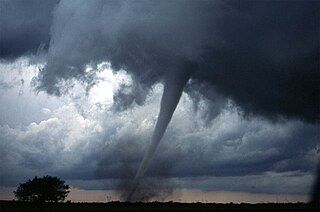
The 1999 Oklahoma tornado outbreak was a significant tornado outbreak that affected much of the Central and parts of the Eastern United States, with the highest record-breaking wind speeds of 301 ± 20 mph (484 ± 32 km/h). During this week-long event, 154 tornadoes touched down. More than half of them were on May 3 and 4 when activity reached its peak over Oklahoma, Kansas, Nebraska, Texas, and Arkansas.

From April 26 to 27, 1991, multiple supercells across Oklahoma and Kansas led to a regional tornado outbreak. Forced by a potent trough and focused along a dryline, these distinct thunderstorms moved northeast through a moist and highly unstable environment. A total of 55 tornadoes were confirmed, many of which were strong, F2 or greater on the Fujita scale. A widely documented F5 tornado tore through Andover, Kansas, killing 17 people. Additional fatalities occurred from significant tornadoes in other portions of Kansas and Oklahoma, with 21 deaths recorded in total. An F4 tornado was detected by a mobile doppler weather radar team which observed winds up to 270 mph (430 km/h) at the top of the funnel, the first time winds of F5 intensity were measured by radar, and the highest winds recorded by radar at the time. A news team filming an F2 tornado sought shelter under a Kansas Turnpike overpass, causing a misconception that overpasses can provide adequate shelter during a tornado. This outbreak occurred within a transition period for the National Weather Service and proved the value of NEXRAD radars, which were utilized in Oklahoma to provide advanced warning to residents.

From April 9–11, 1947, a significant tornado outbreak produced catastrophic effects over portions of the southern Great Plains, in the contiguous United States. The outbreak generated at least 12, and possibly 17 or more, tornadoes, many of which were significant. On Wednesday, April 9, a series of related tornadoes spawned by a single supercell, dubbed the Glazier–Higgins–Woodward tornadoes, swept through the U.S. states of Texas, Oklahoma, and Kansas. Most of the damage and nearly all of the deaths are still blamed on one large tornado, known as the Glazier–Higgins–Woodward tornado, that traveled 98 mi (158 km) from Texas to Oklahoma, beginning over the South Plains. This event, up to nearly 2 mi (3.2 km) in width, was often compared to the Tri-State tornado, because it was originally thought to have left a 198-to-221-mile-long path, was similarly large and intense for much of its path, and was also retroactively rated F5 on the modern-day Fujita scale, but it is now believed to have been part of a 125-to-170-mile-long family of nine or 10 tornadoes.

This article lists various tornado records. The most "extreme" tornado in recorded history was the Tri-State tornado, which spread through parts of Missouri, Illinois, and Indiana on March 18, 1925. It is considered an F5 on the Fujita Scale, holds records for longest path length at 219 miles (352 km), longest duration at about 3+1⁄2 hours, and it held the fastest forward speed for a significant tornado at 73 mph (117 km/h) anywhere on Earth until 2021. In addition, it is the deadliest single tornado in United States history with 695 fatalities. It was also the third most costly tornado in history at the time, when costs are normalized for wealth and inflation, it still ranks third today.
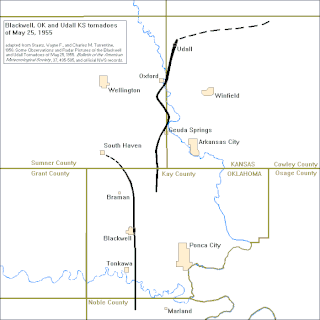
The 1955 Great Plains tornado outbreak was a deadly tornado outbreak that struck the southern and central U.S Great Plains States on May 25–26, 1955. It produced at least 47 tornadoes across seven states including two F5 tornadoes in Blackwell, Oklahoma, and Udall, Kansas that caused most of the casualties. The outbreak killed 102 people while injuring hundreds more. Unusual electromagnetic activity was observed, including St. Elmo's fire.
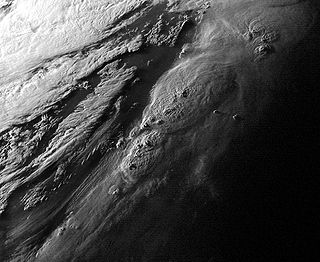
From May 4–6, 2007, a major and damaging tornado outbreak significantly affected portions of the Central United States. The most destructive tornado in the outbreak occurred on the evening of May 4 in western Kansas, where about 95% of the city of Greensburg in Kiowa County was destroyed by an EF5 tornado, the first of such intensity since the 1999 Bridge Creek–Moore tornado. The supercell killed 13 people, including 11 in Greensburg and two from separate tornadoes. At least 60 people were injured in Greensburg alone. It was the strongest tornado of an outbreak which included several other tornadoes reported across Oklahoma, Colorado, Kansas and South Dakota that occurred on the same night.

The Tornado outbreak of June 7–8, 1984 was a significant severe weather and tornado event that took place across the central United States from North Dakota to Kansas on June 7–8, 1984. The tornado outbreak produced several significant tornadoes including an F5 tornado which traveled through Barneveld, Wisconsin, in the early hours of June 8, 1984. The entire outbreak killed at least 13 people across three states including 9 in Barneveld alone.

On February 21–22, 1971, a devastating tornado outbreak, colloquially known as the Mississippi Delta outbreak, struck portions of the Lower Mississippi and Ohio River valleys in the Southern and Midwestern United States. The outbreak generated strong tornadoes from Texas to Ohio and North Carolina. The two-day severe weather episode produced at least 19 tornadoes, and probably several more, mostly brief events in rural areas; killed 123 people across three states; and wrecked entire communities in the state of Mississippi. The strongest tornado of the outbreak was an F5 that developed in Louisiana and crossed into Mississippi, killing 48 people, while the deadliest was an F4 that tracked across Mississippi and entered Tennessee, causing 58 fatalities in the former state. The former tornado remains the only F5 on record in Louisiana, while the latter is the deadliest on record in Mississippi since 1950. A deadly F4 also affected other parts of Mississippi, causing 13 more deaths. Other deadly tornadoes included a pair of F3s—one each in Mississippi and North Carolina, respectively—that collectively killed five people.

A long-lived tornado outbreak sequence affected the Southern Plains, the southeastern and Middle Atlantic region of the United States from May 7–11, 2008. The storm produced 120 confirmed tornadoes starting on May 7 and lasting until late on May 11. The outbreak sequence killed 28 people across several states; 25 were killed by tornadoes. The event occurred less than a week after a deadly tornado outbreak that principally affected the state of Arkansas and killed 7 people.
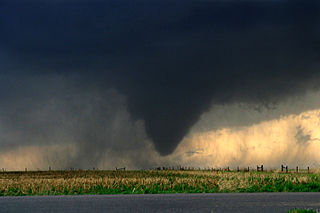
A multi-day tornado outbreak affected the central plains of the United States from May 22–27, 2008. It was also one of the largest continuous tornado outbreaks on record. A total of 173 tornadoes were confirmed, with the most intense activity occurring across the Great Plains. One person was killed when a large wedge tornado struck Windsor, Colorado, and two more deaths were reported in Pratt County, Kansas. One person was also killed near Hugo, Minnesota on May 25 and nine were killed by an EF5 tornado that destroyed most of Parkersburg, Iowa and a small subdivision of New Hartford, Iowa. Another fatality, caused by lightning related to the storms, occurred in central Kansas.

Tornadoes are more common in the United States than in any other country or state. The United States receives more than 1,200 tornadoes annually—four times the amount seen in Europe. Violent tornadoes—those rated EF4 or EF5 on the Enhanced Fujita Scale—occur more often in the United States than in any other country.

This page documents the tornadoes and tornado outbreaks of 1985, primarily in the United States. Most tornadoes form in the U.S., although some events may take place internationally. Tornado statistics for older years like this often appear significantly lower than modern years due to fewer reports or confirmed tornadoes.

The 1999 Bridge Creek–Moore tornado was a large and exceptionally powerful F5 tornado in which the highest wind speeds ever measured globally were recorded at 135 metres per second by a Doppler on Wheels (DOW) radar. Considered the strongest tornado ever recorded to have affected the metropolitan area, the tornado while near peak intensity devastated southern portions of Oklahoma City, Oklahoma, United States, along with surrounding suburbs and towns to the south and southwest of the city during the early evening of Monday, May 3, 1999. Parts of Bridge Creek were rendered unrecognizable. The tornado covered 38 miles (61 km) during its 85-minute existence, destroying thousands of homes, killing 36 people, and leaving US$1 billion in damage, ranking it as the fifth-costliest on record not accounting for inflation. Its severity prompted the first-ever use of the tornado emergency statement by the National Weather Service.

From April 13 to 16, 2012, a major tornado outbreak occurred across a large portion of the Great Plains. The storms resulted in six tornado-related fatalities, all of which occurred as a result of a nighttime EF3 tornado that caused major damage in and around Woodward, Oklahoma. Numerous other tornadoes occurred, including a violent EF4 tornado that passed near Marquette, Kansas, and an EF3 that caused major damage in Wichita.
On December 18–20, 1957, a significant tornado outbreak sequence affected the southern Midwest and the South of the contiguous United States. The outbreak sequence began on the afternoon of December 18, when a low-pressure area approached the southern portions of Missouri and Illinois. Supercells developed and proceeded eastward at horizontal speeds of 40 to 45 miles per hour, yielding what was considered the most severe tornado outbreak in Illinois on record so late in the calendar year. Total losses in the state were estimated to fall within the range of $8–$10 million.

This page documents the tornadoes and tornado outbreaks of 1974, primarily in the United States. Most tornadoes form in the U.S., although some events may take place internationally. Tornado statistics for older years like this often appear significantly lower than modern years due to fewer reports or confirmed tornadoes.
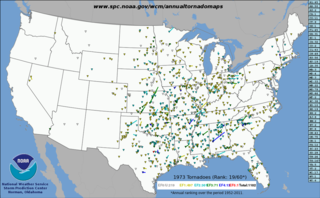
This page documents notable tornadoes and tornado outbreaks worldwide in 1973, but mostly features events in the United States. According to tornado researcher Thomas P. Grazulis, documentation of tornadoes outside the United States was historically less exhaustive, owing to the lack of monitors in many nations and, in some cases, to internal political controls on public information. Most countries only recorded tornadoes that produced severe damage or loss of life. Consequently, available documentation in 1973 mainly covered the United States. On average, most recorded tornadoes, including the vast majority of significant—F2 or stronger—tornadoes, form in the U.S., although as many as 500 may take place internationally. Some locations, like Bangladesh, are as prone to violent tornadoes as the U.S., meaning F4 or greater events on the Fujita scale.

This page documents the tornadoes and tornado outbreaks of 1947, primarily in the United States. Most recorded tornadoes form in the U.S., although some events may take place internationally. Tornado statistics for older years like this often appear significantly lower than modern years due to fewer reports or confirmed tornadoes.


















